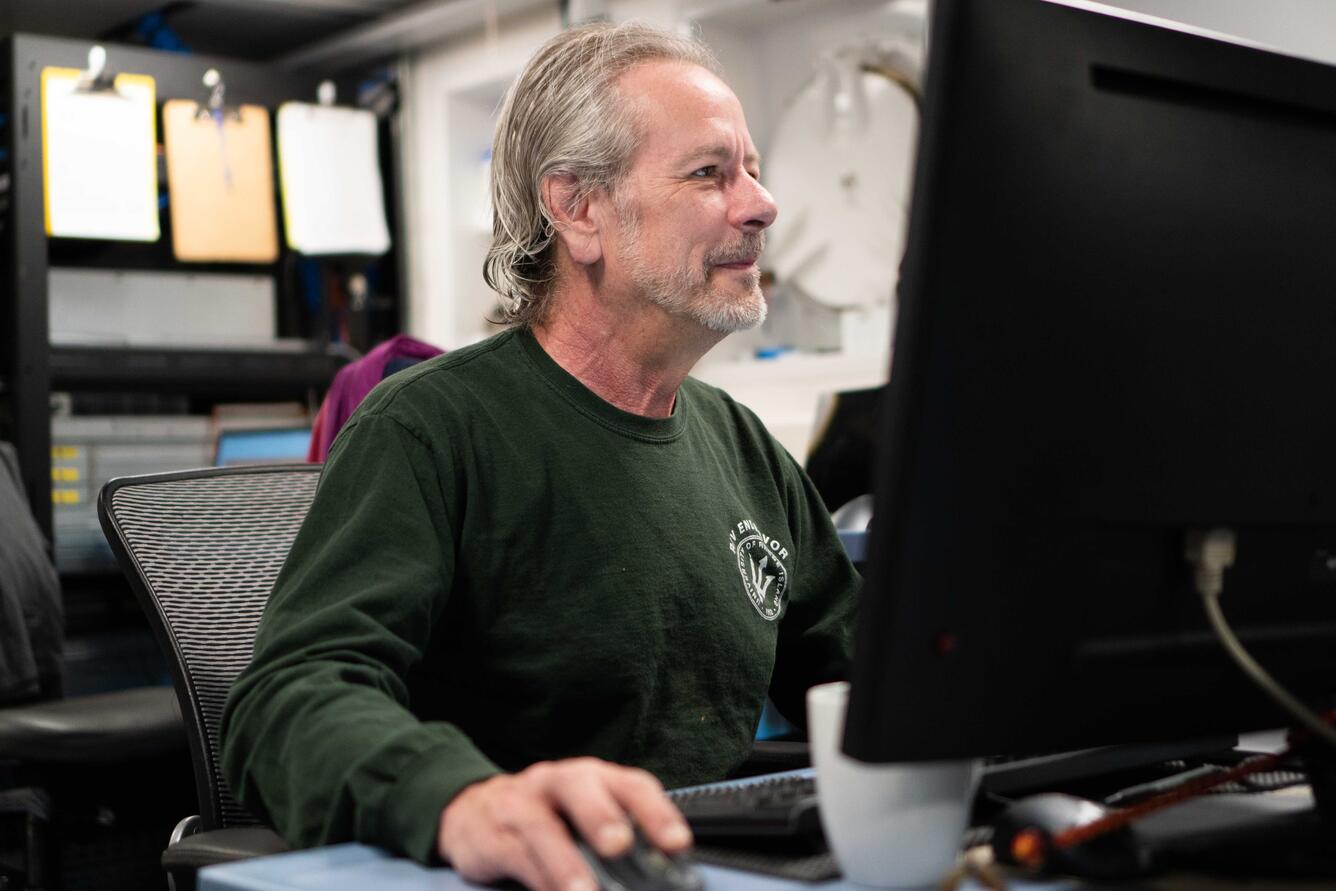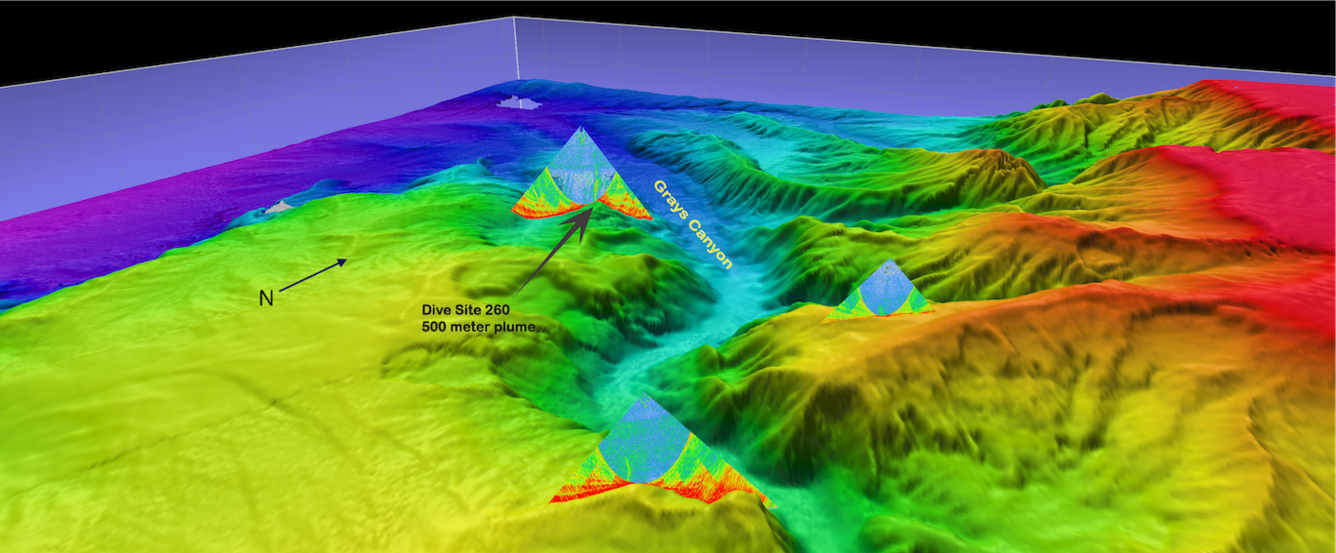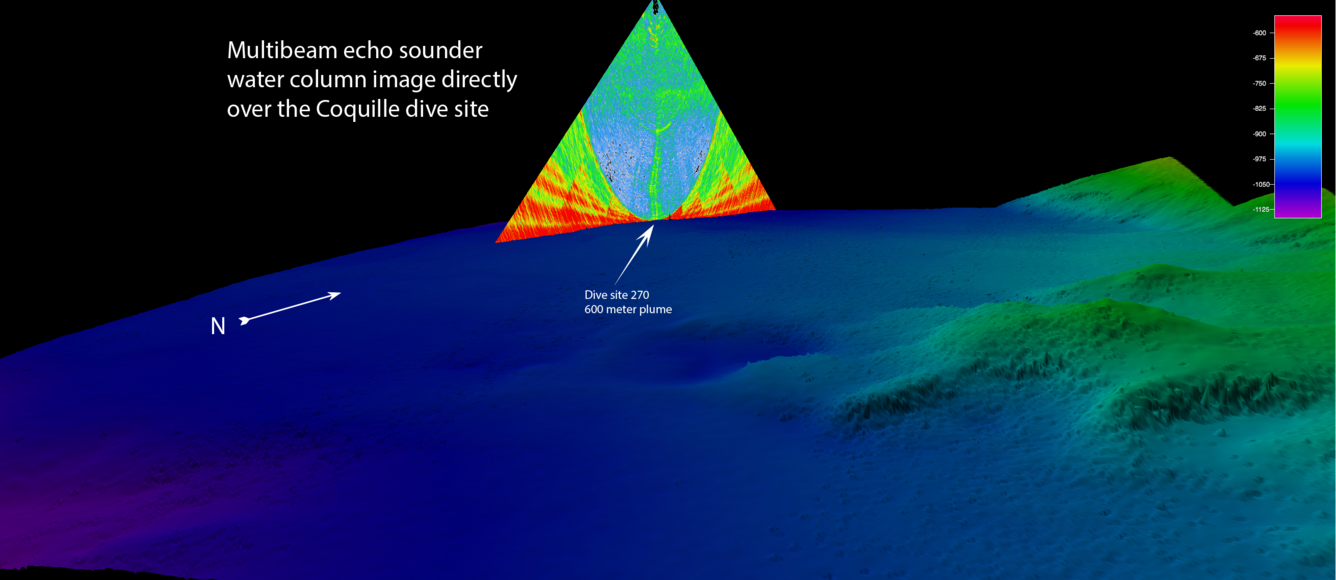Mapping by Moonlight
How USGS Scientist Bill Danforth Plans Our Path Forward
Every successful expedition has a skilled pathfinder who points the way. Meet ours.
Setting sail on the R/V Falkor a few weeks ago to explore unknown features in the Pacific Ocean led us to consider the Lewis and Clark Expedition, which overwintered in Astoria, Oregon in 1805 after crossing the continent and leaving markers and waypoints for those who would follow them.
During the #HuntingBubbles cruise we have our own wayfinder, who goes before us to suggest ROV dive locations and who marks the spot where bubble plumes connect to seafloor seeps. He is USGS scientist Bill Danforth, who maps the seafloor with cutting-edge technology, ferreting out plumes and filling in the gaps on our charts of the ocean bottom.
The Essential Man
“Bill’s work is essential,” USGS scientist and cruise leader Amanda Demopoulos commented. “He’s not only collecting data to create better maps of the seafloor, but he’s also finding both plumes that have been seen in the past and discovering new ones for us to visit.”
“Oh yes, Bill has been a tremendous help,” agreed GEOMAR scientist and resident bubble expert Jens Greinert. “Each night before I go to bed, I check with him and discuss targets to look for. When I wake up, he has sites already chosen that meet those targets.”
Bill’s maps are also filling in data gaps for the USGS Cascadia Hazards project and for NOAA’s Pacific Marine Environmental Laboratory (where Tamara works). This mapping will help with planning future research cruises, assessing offshore faults and seafloor deformation, informing marine ecosystem research, and filling in maps of methane plumes.
Night Watch
Navigating the corridors of R/V Falkor on most days, you won’t see Bill out and about. That’s because he runs the Night Watch, monitoring the screens and instruments of the Falkor while the rest of us recover from the day’s research.
It might seem lonely, but Bill doesn’t mind.
“I actually prefer the quiet,” he says. “There’s a certain serenity to monitoring the screens while all you hear is the creaking of the ship and the lapping of the waves. The only hard part is the beginning and end of each cruise, where I have to get on and off the daytime sleep schedule.”
And Bill’s mapping work is not the only activity taking place at night. R/V Falkor never truly rests. In addition to overnight seafloor mapping and water column imaging, the ship often conducts water column Conductivity, Temperature, and Depth measurements (CTD) at night. When all this information is combined, it provides a rich background canvas on which the specific information from various seeps can be added as detail.
Multibeam Mapping
Our tools for mapping the seafloor have advanced considerably from the lead sounding lines of Lewis and Clark’s days. Today, Bill and other USGS scientists who do seafloor mapping mostly make use of a tool called a multibeam echosounder.
“The multibeam works by sending out a narrow fan of sound energy perpendicular to the ship's track from the hull of the ship where the multibeam echo sounder is installed,” Bill explains. “As each fan of sound energy hits the seafloor or something in the water column, it bounces energy back to the ship and the computer makes images from the readings. My job is to interpret the images and figure out which sites to recommend for further surveys or ROV dives.”
The primary use of the multibeam is mapping the seafloor and its roughness, but the instrument can also image the water column. Bill uses the water column images to search for methane bubble plumes, also called flares, which are emitted at some seafloor seep sites. The stronger the flare signal, the more attractive the site. Sometimes, it’s a matter of choosing amongst a veritable smorgasbord of options.
“Astoria Canyon had dozens of flares, and the canyon itself is well mapped, so that one was easy,” Bill said.
Other locations have not proved so cooperative.
“The biggest challenge is seeing flares on the screens at night and identifying the potential seep locations, only to learn that the other scientists found no methane emission at the seafloor during the next day’s ROV dive,” Bill points out. “We’re seeing that seeps can really change over time, with processes like tidal fluctuations affecting how many bubbles come out. So I can see a place with a strong signal, then 6 hours later, the ROV is hunting around trying to find even one or two bubbles.”
Still, that information about the changes in seepage with time is valuable. Since part of what we’re out here to learn about is how these seeps function—what fuels them, what governs the rate and frequency of their bubbles, and how much gas escapes them—knowing that there is change over time is useful. After all, that’s part of what Jens and Tim were measuring with their own sonar tool.
Mapping by Moonlight
For now, we have reached the central Oregon margin and a site called Coquille, the fourth and final focus area that we’re visiting on this cruise. Bill has mapped several spots for us to visit (make sure to follow along as we explore them!), and we’ll tick them off as we go. And each night, after the ocean bottom mud has been washed off the carbonates, the biological samples labeled and stored, the gas extracted from the samplers, and the rest of us have gone to our bunks, Bill will be up with the silent ship, plotting our next course.
Get Our News
These items are in the RSS feed format (Really Simple Syndication) based on categories such as topics, locations, and more. You can install and RSS reader browser extension, software, or use a third-party service to receive immediate news updates depending on the feed that you have added. If you click the feed links below, they may look strange because they are simply XML code. An RSS reader can easily read this code and push out a notification to you when something new is posted to our site.









